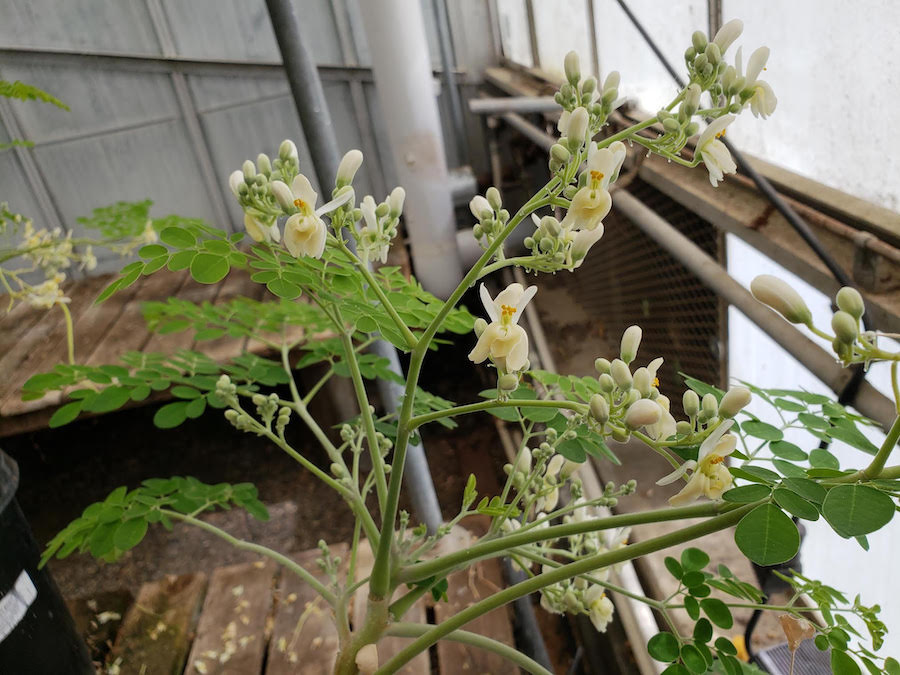
Recent efforts strive to research moringa’s benefits and spread awareness within the U.S.
Although predominantly found in warmer regions such as India and Africa, moringa oleifera, a cruciferous plant, seems to be picking up momentum within the United States. Various research studies are being conducted to evaluate its many uses.
Carrie Waterman, an assistant professional researcher in the UC Davis Department of Nutrition, has dedicated many years into delving deeper into the chemistry and utilization of the plant. While serving as a teacher in math and science in the Peace Corps, Waterman met several other volunteers within the group who were involved with planting moringa in communities in Africa and using it to treat malnutrition in children. Through their experiences, she began to learn about the different uses of each part of the plant.
As Waterman has always had a love for plants, she draws inspiration from ones that have special characteristics. While working as a postdoctoral researcher at Rutgers University examining plants that could potentially treat metabolic syndromes such as obesity, Waterman suggesting looking deeper into the chemistry of moringa. Through research in both cell and animal models, she was able to discover moringa’s anti-inflammatory properties and found connections to other cruciferous vegetables such as broccoli. Through continued studies, Waterman began to discover moringa’s other unique characteristics, such as its low water content. This allows the plant to be denser, contributing to its high quantity of nutrients and ability to survive drier conditions.
“I’m just inspired when I find plants that have really interesting properties,” Waterman said. “And what’s nice is that moringa’s really a vegetable, so it can be eaten as a food, and I think sometimes we need to take care of ourselves from the food that we eat.”
Waterman is currently halfway through a five-year grant funded by the National Institutes of Health where she travels to various regions in Kenya testing moringa growth in different climates in order to advise local farmers. She described the best part of her job as the opportunity to talk to the people who are living off of the land and hear their stories. While she faces obstacles such as transportation and communication, she stated that the challenges keep the experience interesting and finds the process very rewarding.
“It’s nice to be in this bridge between academia and the real world where people are fighting for food security and nutrition and health,” Waterman said. “It’s such a unique experience, and it’s good that UC Davis is supporting more exposure because it just increases your perspective of what’s going on in the world and what people are facing.”
Allen Van Deynze, the director of research for the Seed Biotechnology Center and associate director for the Plant Breeding Center at UC Davis, is also working on moringa through plant breeding for the African Orphan Crops Consortium, which is tackling the issue of stunting due to malnutrition. The goal of the consortium is to look at crops currently being grown in Africa that are used in rural diets and make them productive. As there is a lot of genetic and trait variation within the species, the consortium hopes to cross plants with various traits through conventional breeding in order to breed something that grows well and is highly nutritious.
“There’s some moringa that will have higher vitamins than others and that’s just natural genetic variation,” Van Deynze said. “That’s what plant breeders do. We measure these things, we select the ones that have the best nutrition, but at the same time we need to figure out which plants are or varieties will grow best locally.”
The initial steps of this process are to take the plants already grown in Africa and grow them within the United States. Once the consortium determines which varieties grow well, then it is time for them to breed the plants to create a breed combining local adaptability, high yield and nutrition. While breeding can usually take up to 15 years, through developing DNA technology and utilizing tools such as genetic markers, Van Deynze and his team can track certain genes linked to traits such as nutrition and growth to shorten this time period to roughly five to seven years. Although moringa can currently be purchased through Amazon as a powder, Van Deynze hopes to see the plant grown locally and show people the benefits of the plant.
“I would love to see it being grown out here so people can first of all taste it,” Van Deynze said. “But also, diversity in food, to me, is wonderful. I’m sure I’m not the only one, so here’s an opportunity for people to try something new, but not only that, it’s good for you.”
Efforts to grow moringa within the United States are also taking place. In California, Ruth Dahlquist-Willard, a Small Farms and Specialty Crops advisor for Fresno and Tulare counties, is currently collaborating with the UC Cooperative Extension and UC Sustainable Agriculture Research and Education program to expand the use of moringa powder as products for small-scale farms. Learning that Bay Area produce buyers were looking to purchase moringa sparked the project.
Dahlquist-Willard was initially exposed to moringa when interning at a nonprofit farm in Florida which was growing tropical and non-tropical fruit. As she continued to learn about moringa through this project, she was surprised with how neon-green the freshly grown moringa was. With the growing popularity of moringa as a superfood within the U.S., Dahlquist-Willard hopes to generate more income for small-scale family farms.
“I would like to see the market for California-grown moringa increase,” Dahlquist-Willard said. “Right now almost all of the moringa powder sold in the US is imported. I see potential for locally grown moringa sourced from small farms to be more widely consumed, especially through local food businesses that source ingredients from local farms.”
Although moringa holds a lot of potential, Waterman advises to proceed with caution and would like to continue studying the plant through large-scale clinical studies. She wants to look at factors of inflammation and blood glucose levels in humans after consumption which could be potentially used to treat inflammatory diseases and diabetes. She hopes to continue spreading awareness of the plant and to study its health benefits.
“I think we all know that eating green leafy vegetables is probably good for us and moringa may be a new plant in the U.S.,” Waterman said. “But we should keep looking for cost-effective and nutritionally dense foods to supplement our diet and be a part of our diet.”
Written by: Michelle Wong — science@theaggie.org






ABC has unveiled the Moringa oil industry’s most productive seeds worldly known as MOMAX3® , which promise to deliver three times the yield of the industry average. ABC’s ability to achieve Seeds yields of 7MT/ha and greater in Year 1‐3 have been ascribed to the confluence of several important traits influencing yield: more at: http://jatrophaworld.org/momax3-moringa-perennial-seed-variety.html